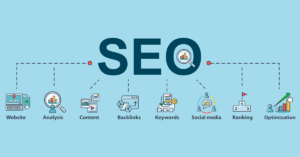Unlike billboards that reach everyone who drives by, SEO strategies target your preferred clients—the ones you want to book appointments. By combining creative content and technical know-how, Pest Control SEO boosts organic search visibility to unlock revenue potential.

Local SEO practices help you rank well in your service area, which builds trust and increases relevant traffic. A thriving Google Business Profile and online reviews boost your rankings, too.
Keyword Research
Keyword research is one of the most important steps in any SEO strategy. It’s the process of discovering and validating keywords that people are using to search for your products or services on search engines like Google. It provides valuable insight into what your audience is searching for and helps you optimize your content to better meet those needs.
Using digital marketing tools, you can verify if a specific keyword is actively searched for (search volume) and presents a reasonable chance of ranking for your website or content (difficulty score). Then, you can use these findings to strategically develop your content and optimize your site to improve its visibility and rankings.
It’s also a great way to keep up with your competitors. Searching for your competition’s keywords can reveal opportunities to create new content that’s more relevant to searchers and could help you rank higher in search results.
Another great benefit of keyword research is that it can help you identify and capitalize on emerging trends. For example, if you notice that certain keywords are getting more popular, it’s a good idea to incorporate them into your content as soon as possible. This can help you gain a competitive advantage over your competitors by being one of the first to recognize and exploit a trend.
Once you have a list of high-performing keywords, it’s important to track their performance over time so you can adjust your content strategy accordingly. For instance, a keyword that is performing well may be driving a lot of traffic or conversions, so it’s worth investing more resources into optimizing your content for that specific keyword.
As a result, the more you invest in your keyword research and optimization, the higher your website will rank on search engine results pages (SERPs). This can ultimately lead to more organic traffic and leads for your business. So, whether you’re just starting or are an experienced SEO expert, always make sure to prioritize your keyword research! The benefits are just too great to ignore.
On-Page Optimization
SEO is one of the most effective ways for pest control companies to build their digital presence. By targeting relevant keyword phrases, enhancing on-page content, and building local citations, pest control businesses can significantly improve their online visibility, ranking, and qualified leads.
Having a well-organized website structure is important for both visitors and search engines. The structure should include clear navigation menus & sitemaps that make it easy for users to find the information they’re looking for. It is also important to have a fast-loading site. By compressing images & using web caching, you can reduce the load time of your pest control website.
Writing informative content is another key factor in pest control SEO. By addressing the questions and concerns that your target audience has, you can establish yourself as an authority in your industry and attract more organic traffic to your website. This content may take the form of blog posts, infographics, or other helpful resources.
Providing your audience with valuable and relatable information will help them trust you as a pest control expert and will encourage them to contact you for services. For example, sharing customer testimonials and before-and-after photos can establish your credibility and create a connection with your audience.
Incorporating keyword-rich, targeted, and long-tail keywords into your website is also a great way to drive more organic search engine traffic. These are words or phrases that are less likely to be competing with many other websites and are highly specific to your business. For example, “signs of squirrels in your attic” and “rat removal from garage” are examples of targeted, long-tail keywords that can be used in your content.
Another essential factor in local pest control SEO is optimizing your Google Business Profile and ensuring that your NAP (name, address, phone number) details are consistent across all online directories and platforms. This ensures that when potential customers are searching for a local pest control company, they can find you quickly.
Off-Page Optimization
The more visible and well-ranked your website is on search engine results pages (SERPs), the more likely you are to attract targeted, qualified leads. This is especially true for niche industries like pest control, which can be competitive and challenging to get noticed in. That is why implementing the right SEO strategies and optimizing on-page elements are essential for your business to thrive in the digital world.
SEO can help you reach your target audience more effectively and grow your pest control business faster than traditional marketing methods. By targeting specific keywords, you can attract users who are looking for your services. This means you can avoid wasting valuable marketing resources on non-relevant traffic and focus your efforts on growing your customer base.
Start by identifying a roster of core keywords that capture the essence of your pest control services. For example, you might use terms like “organic pest solutions,” “extermination services,” and “rodent removal.” Assemble a list of local search intent keywords by adding location modifiers to these terms, such as “city name,” “neighborhood,” or “zip code.”
Build your online presence by claiming your local business listings on platforms like Google Business Profile and Bing Places for Business. Update these listings with your services, contact information, and working hours to bolster your local SEO. Also, encourage your past customers to leave reviews and testimonials to improve your credibility.
Keep up with the latest industry trends and algorithm updates by regularly analyzing your Google Analytics data. This can help you identify and adjust your SEO strategies in response to changing user behavior and market conditions.
Invest time in creating quality content that is useful and engaging for your target audiences. This can include blogs, educational articles, and videos. A blog is a great way to incorporate targeted keywords naturally and share expert advice with your audience. Similarly, video content can be a powerful tool to increase your brand visibility and demonstrate your expertise in the industry. Lastly, optimize your web pages to load quickly to improve user experience and boost your ranking.
Link Building
Search engine optimization is the cornerstone of a solid marketing strategy, allowing pest control companies to effectively compete in crowded online spaces and turn searches into service calls. The complex landscape of SEO can seem intimidating, but with the right mix of strategic thinking, precise actions, and consistent refinement, pest control marketers can master SEO to boost their online visibility and rank higher in search results.
Begin by pinpointing a roster of core keywords that capture the essence of your services. Then, dig deeper with long-tail keywords and local-specific variations to uncover a treasure trove of opportunities to attract niche audiences and generate highly targeted traffic. It’s important to grasp the specific motivations, needs, and goals behind each search query that lands on your site so you can craft content that resonates with potential customers throughout their decision-making journey.
Quality content is one of the most effective marketing for pest control strategies, allowing you to naturally incorporate relevant keywords while sharing useful information with website visitors. Create informative articles, blog posts, and FAQs that highlight the causes of common pest problems, provide helpful solutions, and showcase your expertise in the field. Incorporate keywords into your meta titles and descriptions, webpage URLs, and image alt text to maximize the impact of your efforts.
Optimizing your website for speed and performance is another critical aspect of boosting your SEO. Ensure your website loads quickly by optimizing images, leveraging browser caching, and minimizing the size of CSS, JavaScript, and HTML code. By implementing these and other technical improvements, you’ll also improve user experience and show Google that your site is well-maintained and regularly updated, which positively impacts your SEO ranking.
Claim and optimize your Google Business profile and other customer review platforms to make it easier for prospective clients to find you. Optimize your profiles by claiming your local business name, adding your address and phone number (NAP), listing the services you offer, and posting high-quality, professional photos.
As more and more consumers rely on online research before hiring local service providers, you must take advantage of every opportunity to promote your pest control services. In addition to optimizing your website and social media, incorporating PPC campaigns, building partnerships for referral marketing, and leveraging local SEO tactics can all help you attract more qualified leads and grow your business.
